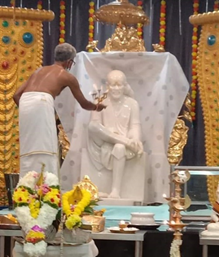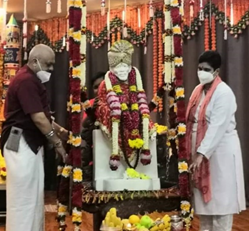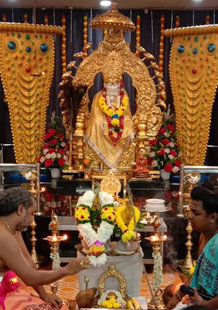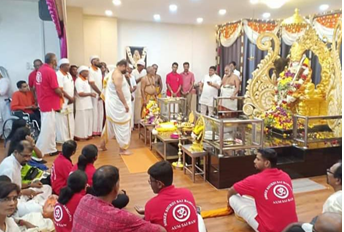KEY FESTIVALS

Maha Shiva Ratri
Mahashivratri, “The Great Night of Shiva” is the most significant event in India’s spiritual calendar. The fourteenth day of every lunar month or the day before the new moon is known as Shivratri. Among all the twelve Shivratris that occur in a calendar year, Mahashivratri, the one that occurs in February-March is of the most spiritual significance. On this night, the northern hemisphere of the planet is positioned in such a way that there is a natural upsurge of energy in a human being. This is a day when nature is pushing one towards one’s spiritual peak. It is to make use of this, that in this tradition, we established a certain festival which is nightlong. To allow this natural upsurge of energies to find their way,one of the fundamentals of this nightlong festival is to ensure that you remain awake with your spine vertical throughout the night. Mahashivratri is very significant for people who are on the spiritual path. It is also very significant for people who are in family situations, and also for the ambitious in the world. People who live in family situations observe Mahashivratri as Shiva’s wedding anniversary. Those with worldly ambitions see that day as the day Shiva conquered all his enemies

Shri Rama Navami
Baba's ardent follower named Gopalrao Gund was childless for a long time and finally was blessed with a son. To offer his thanks to Baba, seeking blessings for the newborn baby too, he took Baba's permission to organise a thanksgiving fair which coincided with Urus, a festival of Muslims in honour of a Sufi saint. As per Sai Charitra book, the day for the Urus was fixed on Ram Navami, after having consultation with Sai Baba. It seems he had some purpose behind this, viz. the unification of the two festivals, the Urus and the Ram Navami Gopalrao Gund had a friend by name Damu Anna Kasar of Ahmednagar. He also was similarly unhappy in the matter of progeny, though he had two wives. He too was blessed by Sai Baba with sons and Mr. Gund prevailed upon his friend to prepare and supply one flag for the procession of the fair. He also succeeded in inducing Mr. Nanasaheb Nimonkar to supply another flag. Both these flags were taken in procession through the village and finally, fixed at the two corners of the Masjid, which is called by Sai Baba as ‘Dwarkamai’. This is being done even now. Shri Rama Navami is a critical festival which is celebrated in Shri Shirdi Sai Baba Temple in Johor giving a perspective of how the festival is celebrated in Shirdi.

Guru Pournima
Dedicated to all the teachers and mentors, who selflessly help humans evolve and become a better version of their self, Guru Poornima is celebrated with much enthusiasm across different places, Guru lineages and traditions. One such special destination, where Guru Poornima celebrations evoke awe and reverence is Shirdi in Maharashtra. At Shirdi, Baba was first seen under a Neem tree where he used to sit in meditation. Baba used to say that the place belonged to His Guru and was naturally and truly fond of that place. Speaking about the importance of this, Baba had said that either on a Thursday or a Friday if anyone comes here, cleans the surface and burns Loban that person would experience all the happiness of life. Baba used to bow down every time He went past that place. Shri Saibaba described the importance of a Guru in a truly detailed manner many a time. On his own accord, Baba never ever preached anyone. However, every word that would come out naturally from his mouth would open up the solutions for the issues that the devotees were battling with in their mind. Baba said, “I stayed at the feet of my Guru for 12 years and He reared me all through. Guru had a huge love for me, and I had no dearth of food and clothes. My GURU was a statue of love and devotion. He had real feelings for his disciples. A Guru like my Guru is hard to find, and one cannot describe the happiness you rejoice in his company.

Thiruvilla (Dussehra & Navaratri)
Vijaya Dashmi (Dussehra) festival is celebrated as Baba’s Maha Samadhi day. The day Baba left his physical body. After the Maha Samadhi of Baba, Vijaya Dashmi or ‘Dussehra’ has come to be the most important festival at Shirdi as the anniversary of the Supreme event – Shri Sai Baba’s Mahasamadhi. Baba left His mortal coil on Vijaya Dashami, October 15, 1918. Two years before, in 1916 Baba had gave an indication of His passing away. It was as follows. On Vijaya Dashami (Dasara) Baba, all of a sudden got into wild rage in the evening, when people were returning from seemolanghan (crossing the border of the village). Taking off His head-dress, kafni and langota, He tore them and threw them into the Dhuni before him. He stood there stark naked and with His burning red eyes shouted, “You fellows now have a look and decide finally whether I am a Muslim or Hindu”. Everybody was trembling with fear, and nobody dared to approach Baba. After some time Bhagoji Shinde, the leper devotee of Baba, went near him and succeeded in tying a langota round His waist and said, “Baba what is all this? Today is seemolanghan i.e., Dasara.” Baba striking the ground with His satka said, “This is My seemolanghan”. Baba did not cool down till 11.00 p.m. and people doubted, whether the Chavadi procession would ever take place that night. After an hour Baba resumed His normal condition and dressing Himself as usual attended the Chavadi procession. By this incident Baba suggested that Vijaya Dashami was the proper time for Him to cross the border of life.

All the updates of weekly aarthis, poojas, annadhanam, birhtday celebrations, Bhajans and Festivals are all updated in facebook as well. Please make an effort to visit the link and subscribe for future updates on regular basis https://www.facebook.com/PER.SSS.BAHGAWAN.JOHOR/
Learn More